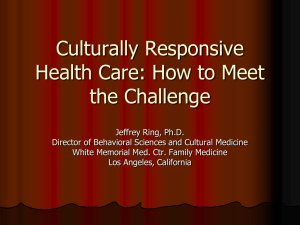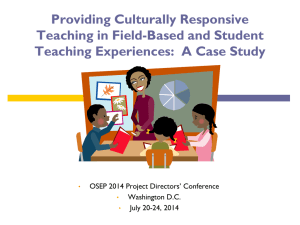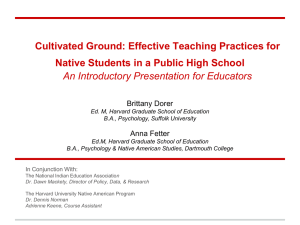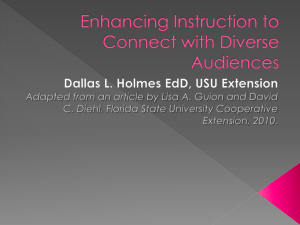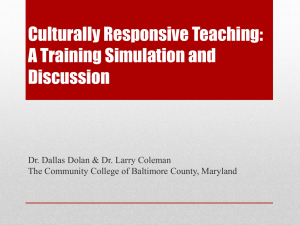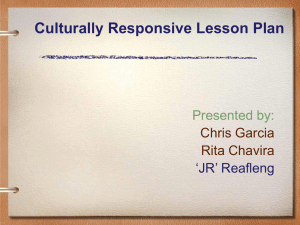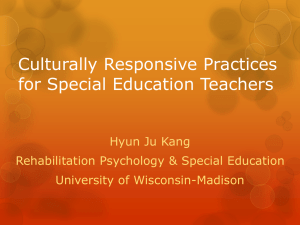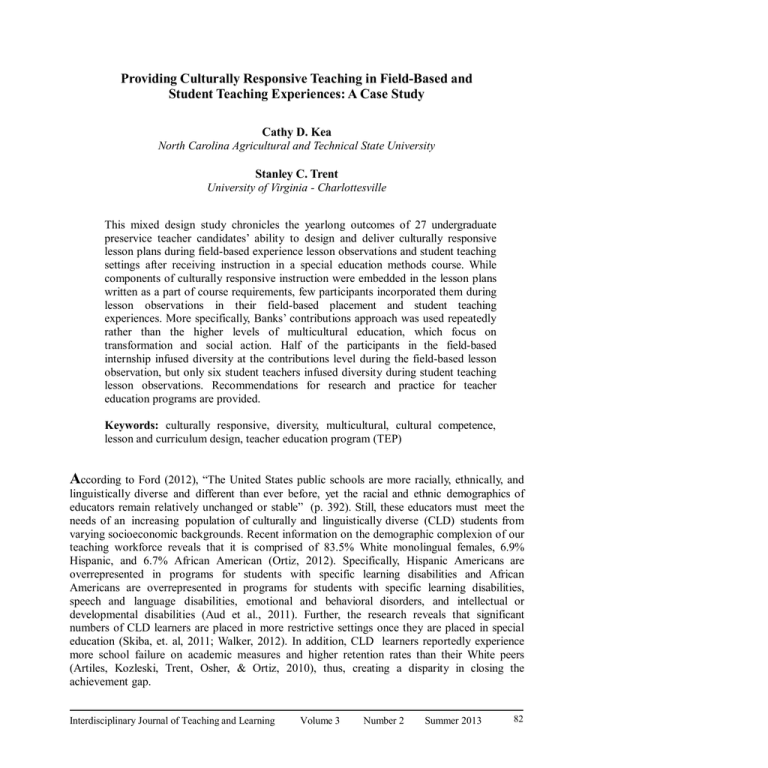
Providing Culturally Responsive Teaching in Field-Based and
Student Teaching Experiences: A Case Study
Cathy D. Kea
North Carolina Agricultural and Technical State University
Stanley C. Trent
University of Virginia - Charlottesville
This mixed design study chronicles the yearlong outcomes of 27 undergraduate
preservice teacher candidates’ ability to design and deliver culturally responsive
lesson plans during field-based experience lesson observations and student teaching
settings after receiving instruction in a special education methods course. While
components of culturally responsive instruction were embedded in the lesson plans
written as a part of course requirements, few participants incorporated them during
lesson observations in their field-based placement and student teaching
experiences. More specifically, Banks’ contributions approach was used repeatedly
rather than the higher levels of multicultural education, which focus on
transformation and social action. Half of the participants in the field-based
internship infused diversity at the contributions level during the field-based lesson
observation, but only six student teachers infused diversity during student teaching
lesson observations. Recommendations for research and practice for teacher
education programs are provided.
Keywords: culturally responsive, diversity, multicultural, cultural competence,
lesson and curriculum design, teacher education program (TEP)
According to Ford (2012), “The United States public schools are more racially, ethnically, and
linguistically diverse and different than ever before, yet the racial and ethnic demographics of
educators remain relatively unchanged or stable” (p. 392). Still, these educators must meet the
needs of an increasing population of culturally and linguistically diverse (CLD) students from
varying socioeconomic backgrounds. Recent information on the demographic complexion of our
teaching workforce reveals that it is comprised of 83.5% White monolingual females, 6.9%
Hispanic, and 6.7% African American (Ortiz, 2012). Specifically, Hispanic Americans are
overrepresented in programs for students with specific learning disabilities and African
Americans are overrepresented in programs for students with specific learning disabilities,
speech and language disabilities, emotional and behavioral disorders, and intellectual or
developmental disabilities (Aud et al., 2011). Further, the research reveals that significant
numbers of CLD learners are placed in more restrictive settings once they are placed in special
education (Skiba, et. al, 2011; Walker, 2012). In addition, CLD learners reportedly experience
more school failure on academic measures and higher retention rates than their White peers
(Artiles, Kozleski, Trent, Osher, & Ortiz, 2010), thus, creating a disparity in closing the
achievement gap.
Interdisciplinary Journal of Teaching and Learning
Volume 3
Number 2
Summer 2013
82
Our racially, ethnically, and linguistically different students are worthy of an equitable education
(Ford, 2012), which means becoming culturally competent is less of an option but rather a
required skill that all educators need to possess (Ford & Kea, 2009).
Culturally Responsive Teaching Matters
Cultural difference is the single most pervasive difference in U. S. schools and the most
neglected (Santamaria, 2009). Several researchers contend that a focus on culturally responsive
teaching (CRT) is needed to address this state of affairs (e.g., Gay, 2010a; Ladson-Billings 1994,
2001). Some of the goals of CRT are illuminated in Banks’ (2005) definition of multicultural
education.
Multicultural education is at least three things: an idea or concept, an educational
reform movement, and a process. Multicultural education incorporates the idea that
all students—regardless of their gender and social class and their ethnic, racial, or
cultural characteristics—should have an equal opportunity to learn in school.
Another important idea in multicultural education is that some students, because of
these characteristics, have a better chance to learn in schools as they are currently
structured than do students who belong to other groups or who have different cultural
characteristics. (p. 3)
In addition to incorporating Banks’ goals to address opportunity and access, CRT incorporates
students’ home/community life and interests into the curriculum, teaching approaches, and the
classroom environment. Also, CRT utilizes a strengths-based approach where all students are
included and expected to achieve (Kea, 2008a). Finally, a very important component of CRT that
is often not addressed is the need to integrate multicultural approaches (e.g., Banks & Banks,
2007) with strategic instruction that develops students’ critical thinking skills and leads to selfregulated learning (Trent, 2003).
Although CRT has been well theorized and documented (Gay, 2010b; Irvine, 2002; LadsonBillings 1994, 2001), it has not been widely operationalized. To date, only seven empirical
studies have examined how preservice and inservice general and special education teachers have
designed and implemented CRT in coursework, field-based, and student teaching experiences.
Of the seven empirical studies, one focused on preservice special education teachers (Kea, Trent,
& Bradshaw, 2012); four focused on preservice general education teachers (Ambrosia, Seguin,
Hogan, & Miller, 2001; Garii & Rule, 2009; Huang, 2002; Salsbury, 2008); two focused on
inservice teachers (Dover, 2010; Udokwu, 2009); and one focused on preservice special
education teachers (Jones, 2008). Some researchers investigated lesson plan design and
implementation as only one part of their study, resulting in limited descriptions and results
pertaining to culturally responsive lesson plans. Results across studies indicate that a significant
number of preservice teacher participants demonstrated minimal skills in preparing lesson plans
that successfully incorporated CRT.
A number of factors have contributed to this lack of implementation of and research on CRT in
special education. First, teacher preparation program (TEP) faculty are unsure about how to
prepare teachers to educate CLD learners from diverse communities in their classrooms (Sleeter
Interdisciplinary Journal of Teaching and Learning
Volume 3
Number 2
Summer 2013
83
& Cornbleth, 2011). Second, diversity is not infused across TEPs in meaningful substantive ways
and most often is addressed in stand-alone courses (Alvarez McHatton, Smith, Bradshaw,
Vallice & Rosa, 2011; Trent, Kea, & Oh, 2008). Third, in most instances, a focus on CRT is not
addressed in other program requirements such as field placements and student teaching (Trent et
al., 2008). Because such knowledge and skills do not occur automatically; they must be taught
across all phases of a teacher education program (Gay, 2010b).
Based on the existing research, we decided to conduct a study to better understand how to
address CRT in TEPs. This research emanates from a larger study that investigated preservice
educators’ ability to design and deliver culturally responsive lesson plans in special education
classroom settings. We examined the yearlong development of teacher candidates’ infusion of
CRT in lesson plans during coursework and lesson delivery in field-based placements and
student teaching. The research questions were as follows:
•
When preservice teacher candidates are exposed to culturally responsive
curricula during coursework, do they infuse it in lesson plan development?
•
When preservice teacher candidates are exposed to culturally responsive
curricula during coursework, do they infuse it in lesson delivery during fieldbased internship lesson observation?
•
When preservice teacher candidates are exposed to culturally responsive
curricula during coursework, do they infuse it in lesson delivery during student
teaching lesson observations?
In addition, this study gave the first author an opportunity to engage in self-study about the
efficacy of her pedagogy in preparing teacher candidates to develop and deliver CRT in urban
settings.
The Program
Located at the largest HBCU in a southeastern state, the special education program is housed in
the School of Education within the Department of Curriculum and Instruction. The department
offers six programs: Bachelor of Science in Elementary Education, Masters of Arts in Teaching
(Elementary Education and Special Education), Masters of Arts in Education (Elementary
Education and Reading Education) and Masters of Science in Instructional Technology. The role
of the department is to prepare a cadre of well-qualified, highly knowledgeable (Pre) K-12
educational professionals who are committed to creating responsive learning communities that
empowers all learners.
The special education program was a stand-alone degree and licensure program for 20 years.
Effective Fall 2005, the undergraduate special education program was integrated/merged under
the elementary education program as a corollary focus area, thus yielding dual licensure in both
elementary and special education. The 134 degree credit program requires 11 special education
courses (32 credit hours) and 200 hours of field-based experiences in special education
classroom settings prior to student teaching. Candidates receive their initial license in special
education general curriculum grades K-12 and elementary education grades K-6. A goal of the
program is to prepare highly qualified personnel from culturally diverse backgrounds who can
Interdisciplinary Journal of Teaching and Learning
Volume 3
Number 2
Summer 2013
84
provide effective instruction utilizing evidence-based best practices and curriculum and
pedagogy responsive to the needs of students with high incidence disabilities in urban school
settings.
Method
Participants
The participants included 27 preservice teacher candidates enrolled in a methods course (SPED
564: Methods, Materials, and Problems in Teaching the Special Needs Child) in the fall
semesters (2006, 2007, 2008, 2009, 2010) as part of their requirement in the Special Education
General Curriculum Teacher Education Program. This course is offered during the fall semester
and includes a 60 hour field-based placement followed by a 15-week student teaching internship
during the spring semester in the same setting as the field-based placement. As shown in Table 1,
the participants were comprised of 12 African Americans, 3 European Americans; 25 females
and 2 males. The mean age was 22 years with a range from 20 to 42 years of age. None of the
participants had teaching experience in general or special education classrooms.
Table 1
SPED 564 Preservice Teacher Candidates’ Demographics
Semester
Number
of
Students
Fall 2006
Fall 2007
Fall 2008
Fall 2009
Fall 2010
Total
1
8
2
5
11
27
Ethnicity
African
European
American
American
1
6
1
5
11
24
---2
1
------3
Gender
Male Female
0
2
0
0
0
2
1
6
2
5
11
25
Class
Mean Age
20
25
22
21
22
22
Number of
Lesson
Plans
Reviewed
3
21
6
15
33
78
Number of
Field Lesson
Observations
Reviewed
1
6
2
5
9
23
Instruments
To assess the preservice teacher candidates’ ability to design and deliver culturally responsive
instruction, three instruments were utilized – the Culturally Responsive Lesson Plan TemplateTM
(Kea, 2008b), the Culturally Responsive Lesson Plan RubricTM (Kea, 2008b), and the Checklist
for Teaching Practices TM (Kea, 2008b). The first two instruments were used to guide the
candidates in designing their lesson plans. It was also used to evaluate the candidates’ lesson
plans. The third instrument was used by the first author (i.e., course instructor) to observe lesson
plan delivery in the field-based and student teaching settings. The extant data from these
instruments were examined and the raw data was recorded on the Lesson Plan Evaluation Data
Form. Descriptions of the three instruments follow:
Culturally Responsive Lesson Plan Template. This template was used to teach a 10-step
lesson plan design format. The 10 steps are: Focus and Review, Lesson Objective, Teacher
Input, Guided Practice, Independent Practice, Closure, Adaptations and Modifications,
Infuse Technology, Infuse Cultural Diversity, and Infuse Working with Families. The
Interdisciplinary Journal of Teaching and Learning
Volume 3
Number 2
Summer 2013
85
template provides a description of the desired outcomes for each step of the lesson
development. 1 (See Appendix A)
Culturally Responsive Lesson Plan Rubric. This rubric defines the observable and
measureable behaviors, knowledge, and skills needed to create each step on the Culturally
Responsive Lesson Plan Template and it is used to evaluate the components of the lesson
plans identified above (see Appendix B). Once again, we focus on two components, which
include lesson design effectiveness and infusion of cultural diversity. A 4-point Likert
scale (1=novice, 2=apprentice, 3=proficient, and 4=distinguished) was used to assess
lesson design effectiveness. Also, the cultural diversity component was based on Banks’
(2002) four diversity approaches using the Likert scale where 1=contributions approach,
2=additive approach, 3=transformative approach, and 4=social action approach.
According to Banks (1999), the contributions approach is the lowest level of diversity
infusion (e.g., the celebration of holidays, heroes and discrete cultural events). The additive
approach adds content, concepts, themes and perspectives to the curriculum without
changing its basic structure (e.g., incorporating several diverse versions of the Cinderella
story or literature about people from different backgrounds). The transformative approach
requires a change in the structure of the curriculum to enable students to view concepts,
issues, events and themes from the perspective of diverse ethnic and cultural groups (i.e.,
A unit on pollution taught to students who live in Bronx, New York, points out that the
highest rates of asthma among children in the U.S. is in this city.). The investigation
incorporates utilizing the zip codes of students in the classroom to locate and visit the
pollution sites. Finally, in the social action approach students make decisions on important
social issues and take actions to help solve them (i.e., Students write letters to their
congressman asking them to address this problem.) (Mensah, 2011).
Checklist for Teaching Practices. During lesson observations, this checklist was used to
evaluate the lesson delivery in six areas: instructional time, student behavior, instructional
presentation, instructional monitoring, instructional feedback, and diversity. A rating (e.g.,
4=distinguished, 3=proficient, 2=apprentice, and 1=novice) for lesson delivery
effectiveness and which of Banks’ diversity approaches were infused during the lesson
delivery was documented. (See Appendix C)
Data Collection
A review of the extant data for this study was conducted during the fall 2011 semester. Consent
was obtained from the Institutional Review Board to review lesson plans, field-based and student
teaching lesson observation outcomes of preservice candidates enrolled in the SPED 564:
Methods, Materials, and Problems in Teaching the Special Needs Child during fall 2006, 2007,
2008, 2009 and 2010. All of these participants completed student teaching the following spring
semester. Prior to the review, identifiers were removed from lesson plans and all lesson
observation forms. A total of 27 preservice teacher candidates were enrolled in this methods
course over the five semesters of which four were non-completers. This accounts for missing
data. For each enrollee, three lesson plans—one each for math, reading and written expression—
1
For the purposes of this study we only present data on lesson design effectiveness and infusion of cultural
diversity.
Interdisciplinary Journal of Teaching and Learning
Volume 3
Number 2
Summer 2013
86
were examined. There was a total of 78 lesson plans. In addition, 23 field-based lesson
observations and 45 student teaching lesson observation outcomes were reviewed. The raw data
from both the lesson plans and lesson observations were transferred onto the Lesson Plan
Evaluation Data Form.
Treatment
On the first day of class, Preservice candidates were asked to develop a baseline lesson plan for
math and submit it prior to lesson plan design instruction. After baseline lesson plans were
collected and analyzed for trends and patterns, preservice candidates were given copies of the
Culturally Responsive Lesson Plan TemplateTM (Kea, 2008b) and Culturally Responsive Lesson
Plan RubricTM (Kea, 2008b) accompanied by detailed instructions on how to create the first six
steps of the lesson plan which denotes instructional presentation (Focus & Review, Lesson
Objective, Teacher Input, Guided Practice, Independent Practice, and Closure). During class
instruction, model lesson plans were shared as guides and additional lesson plans that received
distinguished scores from previous semesters were given as handouts and placed on Blackboard
to provide reference points. Based on the work of Leonard and colleagues (Leonard, 2007;
Leonard & Martin, 2013) the content area of mathematics was used to help teacher candidates
visualize what CRT should look like in the classroom. Mathematics was chosen first because we
thought our teacher candidates could more easily help their students connect their everyday
experiences to mathematical concepts identified in the curriculum. For example, how can one
use a restaurant menu, hip-hop celebrity fragrances or clothing lines, local and state athletic team
scores, neighborhood community stores, and social issues within the community to teach
mathematical concepts in a culturally responsive way? After instruction, preservice candidates
were asked to develop a second draft of their baseline lesson plan and feedback was provided.
Then the last four steps (Adaptations & Modifications, Infuse Technology, Infuse Cultural
Diversity, and Infuse Working with Families) of the Culturally Responsive Lesson Plan
TemplateTM (Kea, 2008b) were reviewed in class. Once again, multiple examples were modeled
and supplemental activities were completed to develop understanding of these four added steps.
Next, preservice candidates were given evidence-based learning strategies in subject matter
content and ways to infuse diversity and home learning activities prior to submitting their final
math lesson plan. Five metacognitive learning strategies developed and validated by the
University of Kansas Center For Research in Learning were presented at this time. They were
DRAW (math), FASTDRAW (math), DISSECT (decoding), RAP (comprehension) and PENS
(writing). The need to integrate these strategies with Banks’ approaches to address affective
engagement and critical thinking for self-regulated learning was stressed.
Content-based instruction in the subject area was given prior to each lesson plan submission, but
preservice teachers were not given additional draft opportunities before lesson submission for the
remaining two lesson plans in reading and written expression in the special education course.
However, after feedback was provided, anyone who received a score at the novice level was
given an opportunity to revise their lesson plans or retain the initial score. Upon completion of
the three lesson plans (math, reading and written expression), preservice candidates scheduled
field-based lesson observations. The first author traveled to the preservice candidates’ school at
an agreed upon time to observe lesson delivery. Preservice candidates were required to teach a
lesson of their choosing and provide a copy of the lesson plan to the instructor prior to the
beginning of lesson delivery. The instructor recorded and rated the lesson delivery outcome
Interdisciplinary Journal of Teaching and Learning
Volume 3
Number 2
Summer 2013
87
using the Checklist for Teaching Practices TM (Kea, 2008b). Upon conclusion of the lesson, a
debriefing session with preservice candidates and field-based supervising teachers was held.
As indicated above, a 60 hour field-based experience was required in the special education
methods course. The field-based experience setting for the methods course served as a yearlong
placement. The preservice candidate taught in the same classroom the following semester. On
average, 2 or 3 lesson observations were conducted in the two content areas—math, reading and
another area of the student teachers’ choosing. Again, a debriefing session was held with student
teachers and cooperating teachers at the end of each delivered lesson.
Data Analysis
For this case study, extant data from lesson plans, field-based placements, and student teaching
lesson observation outcomes were analyzed. During the fall semester, data points included three
lesson plans (math, reading, and written expression) and one field-based lesson observation.
During the spring semester, 2 or 3 completed student teaching lesson observations, which
included anecdotal records, were examined for each participant enrolled in the undergraduate
special education methods course during fall 2006, 2007, 2008, 2009 and 2010 semesters.
Focal to this study were two components of the 10-step lesson plan template: Lesson Design
Effectiveness and Diversity Infusion as described on the Culturally Responsive Lesson Plan
RubricTM (Kea, 2008b). The extant data were analyzed using descriptive statistics. Percentages
were generated for the presence or absence of the two lesson plan components. Lesson design
effectiveness percentages denoted the number of lesson plans at the distinguished, proficient,
apprentice, and novice level. Diversity infusion was the percentage of lesson plans utilizing
Banks’ (2002) four diversity approaches C.A.T.S. (i.e., contributions, additive, transformative,
and social action). Lesson delivery effectiveness was the preservice candidates’ overall score on
the delivery of the developed lesson plan. Inter-rater reliability was conducted between the first
author and graduate research assistants for the methods course lesson plans, field-based and
student teaching lesson observations. The inter-rater score was .98 between the two reviewers.
Lesson Design and Delivery Results
The Course. Data results for the 27 preservice teacher candidates enrolled in the methods course
during the fall 2006, 2007, 2008, 2009 and 2010 semesters are displayed in Tables 2, 3, and 4
respectively. The majority (65.5%, n=51) of the 78 lesson plans were between the proficient and
distinguished levels, 64.1% (n=50) infused diversity at the contributions level, 2.6% (n=2) at the
additive level, and 33.3% (n=26) did not address diversity.
Field-based Placement. Eighty-two percent (n=19) of the 23 preservice teacher candidates’
lesson delivery effectiveness observation scores were between distinguished and proficient. The
mean lesson delivery effectiveness observation score was 16.5 (proficient) out of 20
(distinguished) for the 23 preservice teacher candidates. Only 52% (n=12) of the 23 preservice
teacher candidates infused diversity (contributions approach) during the one field-based lesson
observation.
Student Teaching. The special education methods course is required of teacher candidates who
seek licensure in special education general curriculum grades K-12. During the five semester
time span, ten (10) teacher candidates discontinued their participation in the study due to: course
Interdisciplinary Journal of Teaching and Learning
Volume 3
Number 2
Summer 2013
88
rigor, inability to pass PRAXIS II exam, realization that the field of special education was no
longer viewed as a career option, or premature program exodus. As seen in Table 4, a total of 17
preservice teacher candidates completed the student teaching experience during spring 2007,
2008, 2009, 2010 and 2011. Forty-five lesson observations were conducted by the first author.
This provided consistency and prior knowledge of the teacher candidates’ performance in lesson
plan design and field-based experience lesson delivery observation outcomes. Only 16% (n=7) of
the 45 lesson observations reviewed infused diversity—four at the contributions level; three at
the additive level. Of the 3 additive lesson plans, two student teachers embedded the additive
level--one person twice.
A retrospective review of the six student teachers who infused diversity in their lesson plan
design and delivery during both field-based and student teaching experiences can be found in
Table 5. Twelve lesson plans were at the proficient level, four at the distinguished level and two
at the apprentice level. The majority (78%, n=14) of the 18 lesson plans infused diversity.
Specifically, 13 lesson plans incorporated the contributions approach; one incorporated the
additive approach. During the one field-based lesson observation, five preservice teacher
candidates addressed diversity by infusing the contributions approach. The mean lesson delivery
effectiveness observation score was 18 (proficient) out of 20 (distinguished) for five preservice
teacher candidates. One candidate struggled with lesson design and delivery. Similarly, 39%
(n=7) of the 18 student teaching lesson observations for the six teacher candidates revealed that 4
lesson observations infused diversity at the contributions level and 3 at the additive level.
Excerpts of examples from three (3) of the six (6) student teachers’ lesson observations follow:
Student Teacher #2:
Completed a “Famous African American” worksheet on nationally
recognized heroes earlier in the week. Next, the students were
asked to research African American heroes in their city/town,
choose one hero, and display four major facts using a graphic
organizer on the computer. Also, students were instructed to design
a poster of their chosen African American town hero for display.
They had little to no knowledge about African American heroes in
their small town (Additive Approach).
Student Teacher #4:
Used everyday home item examples for math concepts to teach
students how to estimate the length of an object using centimeters
and inches. A rap song was developed to help her 5th grade
students remember the metric and British systems before lesson
delivery and was taught during the math class (Additive
Approach).
Student Teacher #5:
Read and discussed the contributions of the Greensboro Four sit-in
by North Carolina A & T college students through a selected
children’s book for first graders (Contributions Approach).
In summary, the majority 64.1% (n=50) of the 78 lesson plans developed in the methods course
infused diversity at the contributions level, 2.6% (n=2) additive level, and 33.3% (n=26) were
absent of diversity. Fifty-two percent (n=12) of the 23 preservice teachers infused diversity at the
contributions level during the one field-based lesson observation. Only six student teachers
infused diversity during the 45 student teaching lesson observations. In four instances the
Interdisciplinary Journal of Teaching and Learning
Volume 3
Number 2
Summer 2013
89
contributions approach was infused and in three, the additive approach was infused. A
retrospective review of the six student teachers that embedded diversity during lesson delivery
revealed that the contributions approach remained prevalent.
Table 2
SPED 564 Lesson Design Effectiveness (Fall 2006 ~ 2010)
Semester
Number of
Lesson Plans
Distinguished
(4)
Proficient
(3)
Apprentice
(2)
Novice
(1)
3
21
6
15
33
78
2
5
3
5
4
19
1
8
2
8
13
32
0
6
1
2
9
18
0
2
0
0
7
9
Fall 2006
Fall 2007
Fall 2008
Fall 2009
Fall 2010
Total
Table 3
SPED 564 Diversity Infusion of Banks’ Four Approaches (Fall 2006~2010)
Semester
Fall 2006
Fall 2007
Fall 2008
Fall 2009
Fall 2010
Number of
Lesson Plans
Social
Action
(4)
Transformative
(3)
Additive
(2)
Contributions
(1)
No
Diversity
(0)
3
21
6
15
33
78
0
0
0
0
0
0
0
0
0
0
0
0
0
0
0
1
1
2
2
14
5
12
17
50
1
7
1
2
15
26
Table 4
SPED 564 Preservice Teacher Candidates’ Student Teaching Performance
Semester
Spring 2007
Spring 2008
Spring 2009
Spring 2010
Spring 2011
Total
1
5
2
5
4
0
1
0
0
0
1
4
2
5
4
1
3
1
5
4
0
2
1
0
0
2
15
6
10
12
Number
of
Diversity
Infused
Lessons
0
2
1
4
0
17
1
16
14
3
45
7
Number
of Student
Teachers
Gender
Males Females
Interdisciplinary Journal of Teaching and Learning
Ethnicity
African
European
American American
Volume 3
Number 2
Number of
Lesson
Observations
Summer 2013
90
Interdisciplinary Journal of Teaching and Learning
Methods Course, Field Experience and Student Teaching Lesson Design, and
Delivery of Six Student Teachers (2007~2011)
Code
Lesson
Design
Effectivenes
s
Written
Reading
Exp.
Volume 3
Name
Race
Gender
1
AA
F
3
2
EA
F
3
EA
4
Diversity Infusion
Component
Field-Based Lesson
Observation
Student Teaching Lesson
Diversity Infusion
Number 2
Math
W.E.
Reading
Math
Effectiveness
Score
Diversity
Score
L1
L2
L3
3
3
1
0
1
20
1
0
1
0
4
3
3
1
1
0
20
1
0
2
0
F
4
4
3
1
1
0
18
1
0
1
0
AA
F
3
3
3
1
1
1
18
1
2
2
0
5
AA
F
3
4
3
0
2
1
16
1
0
1
0
6
AA
F
2
2
3
1
1
1
6
0
0
1
0
Note: Lesson Design Effectiveness Scores: 4 = Distinguished; 3 = Proficient; 2 = Apprentice; 1 = Novice
Summer 2013
91
Discussion: Too Much, Too Little, Too Late
The purpose of this study was to gain a better understanding of how special education preservice
teacher candidates infused CRT in lesson plans during coursework, field-based and student
teaching experiences after receiving instruction in culturally responsive curricula in a methods
course. This study also sought to examine the first authors’ efficacy in preparing teacher
candidates to integrate multicultural content in lesson plan design and delivery over time.
The first author has taught this methods course for twenty years at the same university. Over
time, content has been incorporated into the course based on discourse and reflection among
professors, teaching assistants (TAs), and students, as well as student evaluations. On-going
examination of the challenges teacher candidates face in teaching CLD learners in high need
urban schools has led to the emergence of a goal-oriented definition of multicultural education
within a special education context. These seven goals developed by Sleeter and Owuor (2011)
include:
preparing teachers to form relationships with students from backgrounds different
from their own backgrounds, to bridge home and school cultures, to integrate
multicultural content into the curriculum, to use pedagogy equitably in the classroom
so they teach all students well, to reduce prejudice and build relationships among
students, and to be change agents who can recognize and challenge injustice (p. 536).
Focal to this methods course was bridging home and school cultures through the integration of
multicultural content in curriculum, lesson plan development, and instructional delivery.
However, findings from this study indicated that participants demonstrated minimal skills in
preparing lesson plans that successfully infused CRT, even though they were effectively
designed. None of the participants’ lesson plans infused diversity at the higher levels of
transformation or social action. Moreover, less than a third infused diversity during field-based
and student teaching lesson observations.
We concluded that these results might have occurred because not enough time was devoted to
exposure of varied culturally responsive activities and multiple examples of how to integrate
diversity in subject matter content. Also, we wondered if changes in content delivery (e.g., more
time, more explicit connections between culturally responsive pedagogy and instruction) would
have resulted in increased integration of CRT in lesson design and delivery. This course is the
last one taken in the methods block by teacher candidates seeking dual licensure and it can be
overwhelming because the course instructor focuses heavily on multiple aspects of effective
teaching (i.e., lesson plan design, metacognitive strategies, evidence-based practices, CRT
infusion in five content areas). Furthermore, the requirement of composing a detailed scripted
lesson plan is laborious and requires anticipation and critical thinking for each step. For example,
the first six steps—focus and review, lesson objective, teacher input, guided practice,
independent practice and closure—denote instructional presentation and effective lesson design.
Then teacher candidates are required to incorporate cultural diversity across these six steps of the
instructional presentation process. This was not an easy task for many of the candidates and not
surprising considering the concept of infusing diversity is both developmental and experiential
(Alvarez McHatton, et al., 2011). Teacher candidates often commented, “this course should be
Interdisciplinary Journal of Teaching and Learning
Volume 3
Number 2
Summer 2013
92
taught first in the methods block”, “it provides the foundation and is all inclusive” and “other
methods courses should utilize the same format as the one that you have provided us”.
Limitations
Just as with any other study, there are limitations to this one. First, the data was retrieved from
extant data documents and candidates were not interviewed to determine why so few were able
to incorporate Banks’ approaches beyond the additive level. Second, the course instructor
collected the data, which may have introduced bias into the data collection and data analysis
processes. Nonetheless, this approach afforded the opportunity to observe first-hand how the
candidates were applying the content presented in the methods course. Third, the small sample
size makes it difficult to generalize the findings to the population at large. However, in some
cases the purpose of inquiry may be to enhance understanding of a specific issue, improve a
program or expand knowledge-base in the field of study (Richardson, 1994). Also, within the
framework of case study research, transferability is more important than generalizability.
Specifically, it is the authors’ responsibility to provide a rich, detailed description of the research
so that those interested in replicating the study will be able to modify the design and methods to
fit their particular settings and contexts. We have provided such a description. Hence, we deem
the outcomes of our research to be valuable and it moves us closer to a more comprehensive
framework for preparing special education teachers to meet the needs of CLD learners more
effectively.
Implications
Findings from this study reveal that multiple opportunities to design and deliver CRT are needed
since most preservice teacher candidates have not had this experience in their K-12 schooling
(Jackson, 2009). In so doing, teacher education programs must reposition “culture” at the center
of all teacher preparation. This means moving away from fragmented superficial treatment of
diversity or the “little dab will do you” mentality. Instead, we recommend restructuring
programs, curriculum revisions, and integrating culturally responsive principles to frame and
guide the implementation of CRT throughout teacher education curriculum across all programs,
inclusive of diverse field-based experiences and internships. This requires continuous collective
reflection and discourse among faculty on how to infuse this content across the program in a
systematic and developmental manner, for example: (a) less lecturing and increased cooperative
learning, (b) micro teaching, (c) lesson plan feedback, (d) diverse culturally responsive teaching
activities using technology, (e) completion of course rubrics across the program to identify how
diversity is infused, (f) study groups to determine how diversity content such as Banks’
approaches will be infused throughout the program, and (g) sustained assessment to monitor and
revise. Similarly, methods course instructors may want to collaborate on the content of all
methods courses, how they will be delivered, the extent to which CRT content will be modeled
and assessed, and the extent to which the teacher candidate will demonstrate mastery in the
classroom setting.
We also learned that field observation placements and student teaching experiences must be
modified to support candidates as they attempt to infuse diversity into their lesson plans and
execute these plans more successfully in the classroom. Accomplishing this goal will require
Interdisciplinary Journal of Teaching and Learning
Volume 3
Number 2
Summer 2013
93
cooperating teachers to be included in ongoing discussions with clinical and methods course
faculty to determine what culturally responsive teaching should look like in the classroom. We
theorize that this collaboration will increase the likelihood that field-based teacher candidates
will exhibit characteristics of culturally responsive teachers (Villegas & Lucas, 2002) and
implement CRT in their lesson plan designs and delivery (Irvine & Armento, 2001).
This study also elucidates the importance of documenting the extent to which teacher candidates
are able to apply what they learn after coursework completion in their assigned classroom
settings. Often as teacher educators, we teach our classes and assume that the teacher candidates
will be able to translate theory into practice during field-based internships, student teaching, and
even into their novice years as teachers. By documenting the extent to which teacher candidates
were able to generalize their learning to the classroom, the first author was able to assess her
practice and identify what needed to happen at the course and program level to bolster
candidates’ understanding and application of instruction.
Finally, this study substantiates the need for more research of this nature. Replicators of this
study must provide rich descriptions of their contexts so that patterns and behaviors can be
identified that either thwart or promote programmatic growth to ensure that it narrows the gap
between stated goals, enactment of goals, and outcomes for teacher candidates and the culturally
and linguistically diverse students they will teach. We must continue to document, on a large
scale, that CRT can be utilized to improve the academic outcomes for all students (Sleeter,
2011).
AUTHOR NOTES
Cathy D. Kea, PhD, is a Professor of Special Education at North Carolina A&T State
University. Her research interest and engagement focuses on the intersection between general
education, special education, and multicultural education. Her current research focuses on
preparing teachers to design and deliver culturally responsive instruction in urban classrooms
and ways to infuse diversity throughout course syllabi and teacher preparation programs. Stanley
C. Trent, PhD, is an Associate Professor of Special Education at the University of Virginia,
Charlottesville. His previous research has focused on disproportionality. His recent work
focuses on creating culturally responsive schools of education through an iterative process for
individual and collective self-study.
This research was supported and funded by the Office of Special Education Programs, Grant
Award Number H325T080033. We wish to thank our graduate assistants, Brandy Baldwin,
Ashley Bracey, and Ashley Compton for their assistance on this project.
Correspondence concerning this article should be addressed to Dr. Cathy D. Kea, Department of
Curriculum and Instruction, North Carolina Agricultural and Technical State University, 1601
East Market Street – 247 Proctor Hall, Greensboro, NC 27411.
E-mail: cdkea@ncat.edu
Interdisciplinary Journal of Teaching and Learning
Volume 3
Number 2
Summer 2013
94
References
Alvarez McHatton, P., Smith, M., Bradshaw, W., Vallice, R., & Rosa L. (2011). “Doing
diversity…?” Preparing teacher candidates using a developmental model. In E. D. McCray,
P. Alvarez McHatton, & C. L. Beverly (Eds.). Knowledge, skills, and dispositions for
culturally competent and interculturally sensitive leaders in education. (pp. 247-268).
Arlington, VA: Teacher Education Division, Council for Exceptional Children.
Ambrosio, A. L., Seguin, C. A., Hogan, E. L., & Miller, M. (2001). Assessing performancebased outcomes of multicultural lesson plans: A component within a comprehensive
teacher education assessment design. Multicultural Perspectives, 3, 15-22.
Artiles, A. J, Kozleski, E. B., Trent, S. C., Osher, D., & Ortiz, A. (2010). Justifying and
explaining disproportionality, 1968-2008: A critique of underlying views of culture.
Exceptional Children, 76(3), 279-299.
Aud, S., Hussar, W., Kena, G., Bianco, K., Frohlich, L., Kemp, J.,…Hannes, G. (2011, May).
The condition of education 2011 (NCES 2011-033). Washington, DC: U.S. Department
of Education, National Center for Education Statistics.
Retrieved from
http://nces.ed.gov/pubs2011/2011033.pdf
Banks, J. A. (2005). Multicultural education: Characteristics and goals (5th ed.) In J. A. Banks &
C. A. Banks (Eds.), Multicultural education: Issues and perspectives (pp. 3-30). Hoboken,
NJ: John Wiley & Sons.
Banks, J. A. (2002). An introduction to multicultural education. Boston, MA: Allyn and Bacon.
Banks, J. A. (1999). An introduction to multicultural education (2nd ed.). Boston, MA: Allyn and
Bacon.
Banks, J. A., & Banks, C. B. (2007). An introduction to multicultural education (6th ed.).
Danvers, MA: John Wiley & Sons.
Dover, A. G. (2010). Teaching for social justice with standards-based secondary English
language arts curriculum. (Doctoral Dissertation). Retrieved from ProQuest Dissertations
and Theses. (Accession Order No. AAT 3397695).
Ford, D. Y. (2012). Culturally different students in special education: Looking backward to
move forward. Exceptional Children, 78(4), 391-405.
Ford, D. Y., & Kea, C. D. (2009). Creating culturally responsive instruction: For students’ and
teachers’ sake. Focus on Exceptional Children, 41(9), 1-16.
Garii, B., & Rule, A. C. (2009). Integrating social justice with mathematics and science: An
analysis of student teacher lessons. Teaching and Teacher Education, 25(3), 490-499.
Gay, G. (2010a). Acting on beliefs in teacher education for cultural diversity. Journal of Teacher
Education, 61(1-2), 143-152.
Gay, G. (2010b). Culturally responsive teaching: Theory, research, & practice (2nd ed.). New
York, NY: Teachers College Press.
Huang, H. (2002). Designing multicultural lesson plans. Multicultural Perspectives, 4(4), 17-23.
Irvine, J. J. (Ed.). (2002). In search of wholeness: African American teachers and their culturally
specific classroom practices. New York, NY: Palgrave.
Irvine, J. J., & Armento, B.J. (2001). Culturally responsive teaching: Lesson planning for
elementary and middle grades. New York, NY: McGraw-Hill.
Jackson, T. O. (2009). Making the readings come to life: Expanding notions of language arts at
freedom schools. The New Educator, 5, 311-328.
Interdisciplinary Journal of Teaching and Learning
Volume 3
Number 2
Summer 2013
95
Jones, T. (2008). Preparing special educators: Infusing multicultural educational practices and
lesson planning in pre-student teaching fieldwork. (Doctoral Dissertation). Retrieved from
ProQuest Dissertations and Theses. (Accession Order No. AAT 3338517)
Kea, C. D. (2008a). How do we define culturally responsive instruction and teaching in today’s
classroom? Paper presented at the Project FIRE Expert Consultant Retreat. North
Carolina A&T State University, Greensboro, NC.
Kea, C. D. (2008b). Culturally responsive lesson plan design collectionTM (TXu1-637-079)
Washington, DC: Library of Congress.
Kea, C. D., Trent, S. C., & Bradshaw, W. (2012). Making the case for culturally responsive
planning in teacher preparation: A review of the literature. Unpublished manuscript.
Ladson-Billings, G. (2001). Crossing over to Canaan: The journey of new teachers in diverse
classrooms. San Francisco, CA: Jossey-Bass.
Ladson-Billings, G. (1994). The dreamkeepers: Successful teachers for African-American
children. San Francisco, CA: Jossey-Bass.
Leonard, J. (2007). Culturally specific pedagogy in the mathematics classroom: Strategies for
teachers and students. New York, NY: Routledge.
Leonard, J., & Martin, D. B. (2013). The brilliance of Black children in mathematics: Beyond
the numbers and toward new discourse. Charlotte, NC: Information Age Publishing.
Mensah, F. M. (2011). A case for culturally relevant teaching in science education and lessons
learned for teacher education. The Journal of Negro Education, 80 (3), 296-309.
Ortiz, A. A. (2012). Implementing standards-based teacher education to prepare culturally and
linguistically responsive special educators: English language learners with disabilities.
Paper presented at the Council for Exceptional Children, Denver, CO.
Richardson, V. (1994). Conducting research on practice. Educational Researcher, 23(5), 8-10.
Salsbury, D. (2008). A strategy for preservice teachers to integrate cultural elements within
planning and instruction: Cultural L.I.V.E.S. Journal of Social Studies Research, 32, 3139.
Santamaria, L. J. (2009). Culturally responsive differentiated instruction: Narrowing gaps
between best pedagogical practices benefiting all learners. Teachers College Record,
111(1), 214-24.
Skiba, R. J., Horner, R. H., Chung, C., Rausch, M. K., May, S. L., & Tobin, T. (2011). Race is
not neutral: A natural investigation of African American and Latino disproportionality in
school discipline. School Psychology Review, 40, 85-107.
Sleeter, C. E. (2011). An agenda to strengthen culturally responsive pedagogy. English
Teaching: Practice and Critique, 10(2), 7-23.
Sleeter, C. E., & Cornbleth, C. (2011). Teaching with vision: Culturally responsive teaching in
standards-based classrooms. New York, NY: Teachers College Press.
Sleeter, C. E., & Owuor, J. (2011). Research on the impact of teacher preparation to teach
diverse students: The research we have and the research we need. Action in Teacher
Education, 33(5-6), 524-536.
Trent, S. C. (2003). So that all people can see themselves: Hearing and heeding the voices of
culturally diverse students who are at-risk for school failure. Educational Leadership,
61(2), 84-87.
Trent, S. C., Kea, C. D., & Oh, K. (2008). Preparing preservice educators for cultural diversity:
How far have we come? Exceptional Children, 74, 328-350.
Interdisciplinary Journal of Teaching and Learning
Volume 3
Number 2
Summer 2013
96
Udokwu, C. J. (2009). Investigation of urban science teachers’ pedagogical engagements: Are
urban science teachers culturally responsive? (Doctoral Dissertation). Retrieved from
ProQuest Dissertations and Theses. (Accession Order No. AAT 3351581).
Villegas, A. M., & Lucas, T. (2002). Preparing culturally responsive teachers: Rethinking the
curriculum. Journal of Teacher Education, 53, 20-32.
Walker, B. L. T. (2012). Teacher education and African American males: Deconstructing
pathways from the schoolhouse to the “big house”. Teacher Education and Special
Education, 35(4), 279-299.
Interdisciplinary Journal of Teaching and Learning
Volume 3
Number 2
Summer 2013
97
Interdisciplinary Journal of Teaching and Learning
Appendix A
Culturally Responsive Lesson Plan Template
Lesson Plan
Teacher
Academic Subject Area
Standard Course of Study Competency Goal #
Objective#
Objective (s)
Area(s) of Exceptionality_
Grade Level
Competency Name
_
_
_
_
_
_
_
Performance Level of Student(s)
Instructional Presentation
Focus & Review
Lesson Objective
Teacher Input
Volume 3
Guided Practice
Independent Practice
Number 2
Closure
Adaptations & Modifications
Infuse Technology
Summer 2013
Infuse Cultural Diversity
Infuse Working w/ Families
Review of previously learned material including three examples or an activity designed to teach the new skill or
concept. The rationale of the lesson must be given and related to home, school and the world of work.
Objectives must be measurable. They should contain a condition, behavior, and criteria. Include an essential
question for the lesson.
Model at least 3 examples of the concept or skill to be taught. The examples should mirror what they will be
doing in guided practice and independent practice. This section must be described in detail. Enough detail
should be provided such that the lesson can be reasonably taught based upon your description.
Hands-on, cooperative groups, and active involvement type activities should be done here. Students are
practicing at least 5 examples of what was taught in teacher input. No worksheets.
Worksheets are allowed here. Students are practicing the same skill or concept taught in teacher input and that
they were engaged in under guided practice. Assessment measure designed should ensure mastery of the
concept/skill at a minimum 80% level by student.
Teacher facilitates summarization of the lesson’s key points. Design five questions to check student
understanding of key concepts and content taught in the lesson. Provide three additional examples to check for
student understanding.
Cite any adaptations and/ or modifications of the designed lesson plan for students in the classroom.
Cite websites used to design the lesson and infuse technology in the lesson presentation during teacher input
and/or guided practice.
Design and state how cultural diversity is infused in the lesson plan (i.e. culturally responsive instruction,
materials, and/or curricula).
Design one (1) home learning activity to reinforce family, student, and teacher interactions and positive learning
outcomes.
*Note* All materials used for the lesson plan must be attached (i.e. PowerPoint, transparencies,
worksheets, cooperative
98
Copyright 2008. All rights reserved by Cathy D. Kea.
Interdisciplinary Journal of Teaching and Learning
Appendix B
Culturally Responsive Lesson Plan Rubric
(4) Distinguished
Volume 3
(3) Proficient
Number 2
Review of previously learned
material or activity designed to
teach the new skill or concept is
stated very well.
Three examples are given.
Rationale for
the
lesson
is related to home, school
and work very well.
Lesson objective is measurable
and
contains:
condition,
behavior and criteria.
Essential question is given.
Standard
course
of
study competency
goals
and objectives are stated.
Content is described explicitly.
Key points
and concepts
are presented very well.
Three
examples
of
the concept/skill are modeled.
Appropriate instructional strategies
for
student
learning outcomes are utilized.
(2) Apprentice
Review of previously learned
material or activity designed to
teach the new skill or concept
is stated well.
Two examples are given.
Rationale for the lesson
is related to home, school
and work well.
Two of the three are given (i.e.
lesson
objective,
essential question, or standard
course of study) and stated
correctly.
Content is described
and covered with a focus.
Key points or concepts
pre- sented well.
Two examples are modeled.
Appropriate instructional strategies were used in the lesson.
Review of previously learned
material or activity designed to
teach the new skill or concept is
stated somewhat.
Only one example given.
Rationale for the lesson is
related
to
home,
school
and work somewhat.
One of the three are given (i.e.
lesson
objective,
essential question, or standard
course of study) and stated
correctly.
Summer 2013
Hands-on, cooperative groups,
active involvement type activity
were very well designed.
Five examples are provided in
text or attached.
No worksheets.
Students are practicing what
was taught in teacher input.
Hands-on, cooperative
group activity was well
designed.
Four examples provided in text
or attached. No worksheets.
Students are practicing what
was taught in teacher input.
99
Copyright 2008. All rights reserved by Cathy D. Kea.
(1) Novice
Review of previously learned
material or activity designed to
teach the new skill or concept
is poorly stated.
No examples given.
Rationale for the lesson is
not related to home, school
and work.
Focus and
Review
Lesson
objective,
essential question or standard
course of study is incorrect for
the lesson or
the
3
components
of the lesson
objective
are
not
measurable.
Lesson
Objective
Generally
described
the
lesson content.
Could tell they knew how
to teach the content, but failed
to make
a
clear
and
concise connection between the
instruct- tional
goals
and
objectives
and
learner
outcomes.
Modeled only one example.
Superficial description
of
the lesson content.
Clearly did not understand
how to teach the concept
nor describe the teaching
process.
Examples
provided
did
not teach the new skill or
concept.
Teacher
Input
Hands-on,
cooperative
group activity design was good.
Three examples provided in text
or attached. No worksheets.
Students
are
practicing
what was taught in teacher
input somewhat.
Hands-on,
cooperative
group activity was poorly
designed.
Two examples provided in text
or attached. No worksheets.
Students
are
not
practicing what was taught
in teacher input.
Guided
Practice
Interdisciplinary Journal of Teaching and Learning
Culturally Responsive Lesson Plan Rubric (Continued)
(4) Distinguished
(3) Proficient
W orksheets are allowed here.
Students
are
practicing
the same skill or concept
taught in teacher input and that
they were engaged
in
under guided practice.
Assessment
measure
supports the acquisition of the
new skill or concept at a
minimum 80% level very well.
Lesson
objective
and
inde- pendent
practice
activity correlate very well.
Activity is described in text, has
explicit
directions,
and is
attached to the lesson plan.
Method
for
assessing
student learning
and
evaluating instruction is clearly
delineated.
Teacher facilitates the summarization of the key points very
well.
Five questions are provided in
text to check for student
understanding
of
key
concepts and content taught in
the lesson.
Three
additional
examples
are given
to
check
for understanding.
Adaptations
and/or
modifications of the lesson plan
are very well designed for
students.
The Social Action Approach
Students
make
decisions
on important social issues and
take actions to help solve them.
Volume 3
Number 2
(2) Apprentice
Summer 2013
W orksheets are allowed here.
Students
are
practicing
the same skill or concept
taught in teacher input and that
they were engaged
in
under guided practice.
Assessment measure supports
the acquisition of the new skill or
concept at a minimum 80% level
well.
Lesson
objective
and independent
practice
activity correlate well.
Activity is described in text, has
good
directions
and is
attached to the lesson plan.
Method
for
assessing
student learning
and
evaluating instruction is good.
Teacher facilitates the summarization of the key points
well.
Four questions are provided
in text
to
check
for
student understanding of key
concepts and content taught
in the lesson.
Two
additional
examples
are given
to
check
for
under- standing.
Adaptations and/or modifications of the lesson plan are
well designed for students.
The Transformation Approach
The structure of the curriculum
is changed to enable students
to view
concepts,
issues,
events, and
themes
from
the perspective of
diverse
ethnic and cultural
groups.
100
Copyright 2008 All rights reserved by Cathy D. Kea.
(1) Novice
W orksheets are allowed here.
Students
are
practicing
the same skill or concept
taught in teacher input and
that
they were engaged in
under
guided
practice
somewhat.
Assessment measure supports
the acquisition of the new skill
or concept at a minimum 80%
level somewhat.
Lesson objective and independent
practice
activity correlate somewhat.
Activity is described in text,
has directions somewhat and
is attached to the lesson plan.
Method
for
assessing
student learning
and
evaluating instruction
is
discussed somewhat.
Teacher facilitates the summarization of the key points
somewhat.
Three questions are provided
in text to check for student
understanding
of
key
concepts and
content
taught in the lesson.
One
additional
example
is given
to
check
for understanding.
Adaptations and/or modifications
of the lesson plan
are somewhat
designed
for students.
The Additive Approach
Content, concepts, themes,
and perspectives are added
to the
curriculum
without changing its structure.
W orksheets are allowed here.
Students are not practicing
the same skill or concept
taught in teacher input and
that
they were engaged in
under guided practice
Assessment measure does not
support the acquisition of
the new skill or concept
at a minimum 80% level.
Lesson
objective
and
inde- pendent practice activity
do not correlate.
Activity is not described in text,
nor directions provided and
is not
attached
to
the
lesson plan.
Method
for
assessing
student
learning
and
evaluating is not discussed.
Independent
Practice
Teacher facilitates the summarization of the key points
poorly.
Two questions are provided in
text to check for student
understanding
of
key
concepts and
content
taught in the lesson.
No
additional
examples
are given
to check
for
under- standing.
Closure
Adaptations and/or modifications
of the lesson plan
are
poorly
designed
for
students.
Adaptations
and
Modifications
The Contributions Approach
Focuses on heroes,
holidays, and discrete cultural
elements.
Infuse
Cultural
Diversity
Appendix C
Checklist for Teaching Practices
University Supervisor’s Observation of Field-Based/Student Teacher
Date
Time
Field-Based/Student Teacher
Cooperating Teacher:
School:
University Supervisor:
Teacher Candidate:
Signature
Signature
Based on your observation, address each of the following areas using statements which accurately reflects the
quality performance of the field-based/student teacher.
1. Management of Instructional Time
2. Management of Behavior
3. Instructional Presentation (Focus and Review, Lesson Objective, Teacher Input, Guided Practice, Independent
Practice, Closure)
4. Instructional Monitoring
5. Instructional Feedback
6. Diversity Delivery Infusion
Implements culturally responsive instruction
Yes
No
Type of approach used:
Contributions Approach (celebrates holidays, heroes and discrete cultural events)
Additive Approach (adds content, concepts, themes and perspectives to the curriculum without
changing its basic structure)
Transformative Approach (requires a change in the structure of the curriculum to enable students to
view concepts, issues, events and themes from the perspective of diverse ethnic and cultural groups)
Social Action Approach (encourages students to make decisions on important social issues and take
actions to solve them)
Elements of Diversity infused in the lesson plan:
Ethnicity
Gender
Religion
Race
Exceptionalities
Sexual Orientation
Socioeconomic Status
Language
Geographical Area
__
Suggestions for Improvement:
Rating (circle one): 4 = Distinguished
3 = Proficient
2 = Apprentice
1 = Novice
Copyright 2008. All rights reserved by Cathy D. Kea.
Interdisciplinary Journal of Teaching and Learning
Volume 3
Number 2
2013
101

